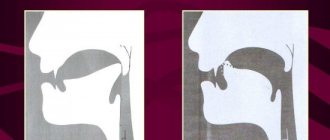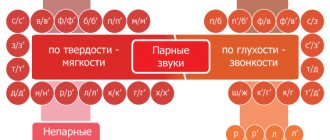Tweet
Probe for producing posterior lingual sounds
Back-lingual sounds (K, G, X) appear in a child’s speech quite early, usually before 2 years of age, but in practice it is not uncommon to encounter children whose pronunciation of these sounds is impaired.
You can read about the correct articulation and violations of the pronunciation of back-lingual sounds (K, G, X, ) here.
In order to prepare the muscles of the tongue for the pronunciation of back-lingual sounds, certain articulatory gymnastics exercises are performed. Basically, these are exercises to strengthen the muscles at the back of the tongue.
Setting the sound K
1. By imitation (if there is no sound). Simulation of a pistol shot.
2. Setting K from the anterior lingual T using a spatula, probe or other available means.
The child says TA-TA-TA. The speech therapist presses with a spatula (probe) on the front part of the back of the tongue, moving approximately 1 cm. It turns out something like this: TA-TYA-KYA-KA.
In some cases, I simply use a finger wrapped in sterile gauze or a clean handkerchief and push the back of the tongue back.
3. From the correct articulatory structure formed with the help of gymnastics. The tip of the tongue is at the lower gums, the back of the back of the tongue is pressed tightly to the palate. Add a strong, sharp short exhalation.
Correct articulation
Any work begins with the child being shown a sound sample. The sound [K] belongs to the group of back-lingual sounds, that is, to pronounce them, the back of the tongue rises. It is from this sound that the rest - [X], [G] and their soft pairs - are made.
Therefore, it is advisable to start the correction with the sound [K]. To pronounce it, the lips take a neutral position or become open. The teeth are open, the tip of the tongue lies at the lower teeth, but does not rest against them. The front and middle backs are lowered, the back ones are raised and rest against the soft palate. The sides of the tongue lightly touch the hard palate. The vocal cords do not tense, the air passes through the closure of the tongue and palate, breaks it and the sound [K] is produced.
Normally, the posterior lingual group appears at an early age. Thanks to sucking, the tongue takes the form of a “slide” and the child is able to pronounce individual sounds.
Difficulties may arise due to a high or narrow palate - in this case, it will not be possible to form a bow. With dysarthria, weakness or tension of individual muscles of the tongue occurs. Sometimes children have poor phonemic hearing. Thanks to it, people distinguish between different speech sounds.
Phonemic (speech) hearing should not be confused with physical hearing! If the first is violated, the child will be able to distinguish non-speech sounds well and respond to the speech of other people, but will poorly perceive what he himself says.
Defective pronunciation of the sound [K] is called kappacism. Sometimes there is no sound, then instead of “Cat” you get “'ot”. The sound may be distorted and a click will be heard instead - this happens due to the bow being too tight.
Replacing [K] with other sounds is called paracappacism. Most often the sound changes to [G], [X] and sometimes to [T]. In this case, in addition to sound production, the speech therapist deals with differentiation.
Setting the sound X
1. From the sound SH mechanically, moving a spatula (probe) or the handle of a teaspoon along the back of the tongue deep into the oral cavity SH-SH-HH-X or SA-SHCHA-HYA-HA
2. From the sound K. Pronounce the sound K with aspiration, i.e. K is not sharp, explosive, but smooth with the opening of the bow and its transition into the gap KXXXX.
3. By imitation (if there is no sound). Imitation of warming hands with breathing.
Speech therapists!
Add your methods of making back-lingual sounds in the comments or write what methods of making back-lingual sounds you usually use.
If you found this information useful, share it with your friends on social networks. If you have questions on the topic, write in the comments. Your online speech therapist, Natalya Vladimirovna Perfilova.
Preparatory stage
Before you start producing sound, you need to develop a base for it. This is articulation and breathing. Speech therapy adopts a step-by-step approach to correcting sound pronunciation. Consistency must not be neglected, otherwise the defect will not be corrected.
The purpose of the preparatory stage in eliminating cappacism is to teach the child to feel the movements of the tongue. A number of exercises are proposed for this.
Articulation gymnastics is always performed in front of a mirror. This is how children develop visual control.
The first exercise is called “Strongman”. The child opens his mouth and smiles widely. The speech therapist wraps the finger in a scarf or bandage and places it on the tip of the tongue, which lies relaxed near the lower teeth. He begins to carefully move the organ deeper into the mouth. At this time, the child resists and pushes out his finger.
The next stage is to place a finger on the middle part of the tongue, moving it deeper into the mouth. Gradually, the preschooler will develop a new sensation; he will be able to move his tongue independently.
The second exercise is “Slide”. The speech therapist shows a sample of performance in front of the mirror. A wide smile with an open mouth. The tip of the tongue rests on the lower teeth, the back part is raised towards the palate. If the child has difficulty, you can help him press the tip.
The third exercise is “Kneading the dough.” Designed to relieve tone and relax. The wide tongue is placed on the lower lip, then lightly slapped with the upper lip.
In order to teach a preschooler to make his tongue wide, use the “Spatula” exercise. The mouth is open, the tongue is protruded and spread on the lower lip. The pose is held for five seconds.
Another way to strengthen your tongue muscles. The child sticks out his tongue, the speech therapist wraps it in a scarf, carefully holds the organ, and the preschooler tries to put it in his mouth.
To develop correct articulation, breathing exercises are used. To do this, they suggest the “Breeze” exercise. The child must make a “Gorochka”, and then blow the piece of paper or candy wrapper from the speech therapist’s hand.
To practice “Gorochka”, you are given a small syringe to chew. It is washed thoroughly and a large part is placed in the mouth. The pear will be pressed against the tip of the tongue, and the child will be asked to chew it lightly.
With a strong gag reflex, training is carried out gradually. The tongue is stroked with a probe to produce the sound [P], gradually moving further and further. You can stroke the upper palate with the ball, gradually moving towards the root of the tongue.
In severe cases, speech therapy massage helps. It can be manual or probe. It can only be prescribed by a specialist.
Speech therapy exercises
It is necessary to work on overall articulation and clarity of speech. For this, simple and interesting speech therapy complexes are used. We present one of these to your attention.
- “Brushing our teeth.” Stretch your lips in a smile, mouth slightly open. Use your tongue to walk alternately over the upper and lower teeth from the back side. Move from left to right and then in the opposite direction.
- "Spatula". Smile again with your mouth slightly open. Place the wide part of your tongue on your lower lip. Stay in this position for 10 seconds. You can start with 5 seconds.
- “Tube”. Extend your tongue as much as possible and tense it. Then, if possible, roll it up into a tube and stay in this position for 5-10 seconds.
- "Swing". Open your mouth slightly and press the wide part of your tongue against your lower teeth. Then raise your tongue to your upper teeth. We linger in each position for 2-3 seconds. In this case, you need to press with maximum force.
- "Slide". Starting position – mouth slightly open. Press the tip of your tongue firmly against the bottom row of teeth. Then, without lifting the tip, press with the wide part of your tongue (it should bend as if). Stay in this position for 5 seconds.
- "Mountain Wind" Place your tongue in the position described in the previous exercise and blow as hard as possible. In this case, the entire speech apparatus should be tense.
Staging methods
Sound production takes place in individual lessons. The first way is by imitation. To do this, the speech therapist shows a sample of articulation, but does not pronounce the sound itself. He just demonstrates how the tongue forms a “mound” and invites the preschooler to repeat. Then they place a cotton ball on his palm and ask him to blow it off. The output will be the correct sound [K], which can be automated.
But it is rarely possible to introduce sound by imitation, so mechanical assistance is used. The Rau probe set includes a special probe for back-lingual sounds. It looks like a wide spatula.
The preschooler continuously pronounces the syllable “TA”, while the speech therapist uses a probe to push his tongue deep into his mouth. After the manipulation, the desired sound will be heard. The probe is held so that the child remembers the pronunciation.
At this point, it is necessary to come up with a designation for the sound. You cannot call it [K], as this will cause the old pronunciation stereotype. “Cough” will do.
The probe is removed and the child is asked to independently reproduce “Cough”. You will have to help a little with the probe so that the preschooler can find the correct position for the tongue. They switch to automation only when there is ideal sound in an isolated position.
You can try to set the sound from the imitation. The speech therapist coughs quietly, producing something like [CHE]. This should be done quietly, almost in a whisper, reducing the gap between coughs. This trick will remove the [X] sound. For visualization, ask the child to bring his palm to his mouth. He will feel the shock of air.
There is also a way to perform it while inhaling. For this purpose, the preschooler is taught to retract his tongue, to collect it like “a snail hiding in its shell.” The tip is placed on the lower lip, slides sharply along the lower part of the mouth and folds into a “peacock”. The speech therapist whispers something similar to “KA”.
From the same “snail in the shell” position, the child pronounces “KA” - he is asked to “let the snail out.” Such a deceptive maneuver will cause an isolated sound and show a new position.
Producing the sound [K] when replacing it with [T] is most effectively done with mechanical assistance. As a substitute for the probe, use a regular spatula or a baby silicone pacifier.
Staging with support
In some situations, [K] can be called from the correct sound. If there is a good [X], then you can try from him. To do this, the child’s attention is focused on the peculiarities of pronunciation - the root of the tongue touches the palate, you need to remember this sensation. You need to press the tip well into the sky, as if to close the “gap” with your tongue, the pressure should be strong. At this moment you need to “cough” and you will get the sound [K].
Then they begin to train the child to pronounce [K] in isolation. The sound can be loud, explosive, intense. In this case, you need to ask him to speak in a whisper. The sound will go away over time.
In order to consolidate the isolated sound, you need to use gaming techniques. The preschooler is asked to sort through glass pebbles, laying them out in the form of a path. Then the fingers “walk” along them, each step is a sound.
Different paths are suitable: those that need to be traced with a finger, laying out patterns, painting over pictures. Children like dynamic games: jump as many times as the sound sounds. You can lay out the track from different positions. Each jump is a change of pose. For example, he jumped and turned to the right, then to the left, etc. Each movement is accompanied by a sound.
Teaching a child to pronounce sounds
There are many different techniques for correct speech production of a baby. But many parents do not know how to teach their child to pronounce letters at home, and therefore immediately turn to speech therapists for help. Although this problem can often be solved at home. You just need to approach the organization of classes correctly. Parents should remember that they should not overload the baby; the duration of each lesson should not exceed 15 minutes. If the child shows reluctance to study, postpone the lessons for a while. By forcing a child to pronounce letters by force, you can forever discourage him from speaking correctly and learning in general.
Before each lesson, it is necessary to sit the child down, making sure that he sits upright. All distracting objects are removed, the TV is turned off. An excellent option would be to practice in front of a mirror so that the child can see not only the articulation of the adult sitting in front of him, but also his own.
Why can't my child pronounce the letter "k"?
A common reason that a child does not say the letter “k” is that parents and other close relatives coo with him, that is, they imitate his undeveloped speech skills. An adult's speech drops to the level of a child's speech. A child, without hearing normally pronounced sounds and letters around him, cannot learn how to pronounce them correctly. In order for the baby to learn to speak correctly, the parents’ speech must be clear and understandable.
Other reasons that prevent a child from correctly pronouncing a particular sound, in particular “k,” are as follows:
- Pathologies of the hearing aid or visual organs.
- Too big or small tongue.
- A short ligament located under the tongue.
- Paresis of the root of the tongue.
- Thin or thick lips that interfere with normal articulation.
- Irregular structure of teeth or jaw.
- Hypotonicity of the root of the tongue.
- Rhinolalia (splitting of the hard and soft palate).
- Gothic, slit-like or narrow structure of the palate.
Exercises for pronouncing sounds
Initially, it is recommended to prepare cards that will depict animals and objects that have problematic letters at the beginning, middle or end. You need to observe whether the pronunciation of a complex letter always turns out to be problematic, or in some positions.
1. To master the letter “C”, it is recommended to use the following exercises:
- “Rails” (when the tongue must “ride” along the inside of the upper teeth).
- “Silence” (repeat the sound “t-sss” several times, stretching the letter “S”).
To reinforce the letter, you need to choose pictures or words where the letter “C” is present: sleigh, sieve, belt, sun, light. You can use sentences: Sasha sows seeds or poems:
"It's dark in the forest,
Everyone has been sleeping for a long time.
One owl doesn't sleep
She’s sitting on a branch.”
2. The letter “Z” is a brother of “S”, only voiced. Therefore, to teach a child to pronounce the letter “Z”, you need to pronounce “s” only by raising your voice. Show your baby by raising your hand to his throat how the muscles tense, making ringing sounds. We fix the letter with words: hare, animal, tooth, star, as well as sentences: A bunny in winter is like a small animal.
3. The letter “C” can be mastered by resorting to the “Silence” exercise, only you need to pronounce not “t-sss”, but “ts-ts-ts”. We fix it with words: heron, chicken, chain, pizza, and sentences: What color is the bird?
4. You can pronounce the letter “Ш” using a little trick: ask the child to pronounce the letter “s”, and use a spoon to lift the baby’s tongue to the sky. The sound will be “sh”. The letter is fixed with the words: awl, whisper, ears, noise; sentences: Our Masha rustles; and also in verse:
“Dear bear, Nice bear, Our bear is all made of plush.”
5. The same trick can be done with the letters “z” and “z”. fix the letter “F” with the words: beetle, hedgehog, toad. And also in sentences: Zhanna is waiting for a book.
6. To master the letter “Ch” , ask your baby to say “t-t-t” while pressing the baby’s cheeks with your fingers. Then you will hear the cherished “h”. To reinforce the letter, ask your child to say the words: tea, turtle, daughter, ball; suggestions: Clean the siskin's bathtub.
7. The most common problem for parents is the problem of the letters “R” and “L”. Techniques and exercises for solving this problem are aimed at teaching the child to growl without swallowing complex letters and without replacing the complex “r” with the easier “l”:
“Horse” - together with your child, imitate the clicking and clattering of a horse’s hooves.
“Brush your teeth with your tongue” - ask your baby to smile widely. Then you need to run your tongue along the inner surface of the upper teeth. Make sure that the child's lower jaw remains motionless.
“Tease” - the child is invited to tease. To do this, the relaxed tongue sticks out and dangles up and down. The teasing is accompanied by a growl.
Special attention in teaching the letters “P” or “L” is paid to tongue twisters:
- The Greek was driving across the river, he saw the Greek: there was cancer in the river.
- There is grass in the yard, there is firewood on the grass: one, two, three there is firewood.
- The brave man ate thirty-three pies, all of them with cottage cheese.
- You can’t say all the tongue twisters quickly.
Secrets to help quickly teach your child to pronounce letters
In addition to direct exercises with the child’s speech muscles and exercises to teach complex letters, it is necessary to pay attention to the development of fine motor skills. Together with your child, sort out the cereals, string beads on a string, and sculpt them from plasticine or dough. And most importantly: while working, do not be silent. Tell your child fairy tales, nursery rhymes or tongue twisters.
Another secret is to teach your child to repeat the letter “D” often. By pronouncing this magic letter, the muscles of the tongue are trained, it is positioned correctly in the mouth, and with constant training, the child will learn to pronounce the complex letter “r”.






